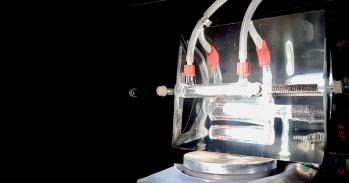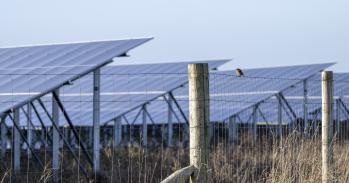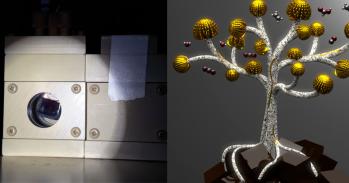
Researchers have quantified the astonishingly high speeds at which future solar cells would have to operate in order to stretch what are presently seen as natural limits on their energy conversion efficiency.
Researchers have quantified the astonishingly high speeds at which future solar cells would have to operate in order to stretch what are presently seen as natural limits on their energy conversion efficiency.
The timescale that we calculated is now the time limit that we have to operate within if we want to create super-efficient, hot carrier solar devices.
Johannes Richter
The study, which investigated photovoltaic devices based on a type of materials called perovskites, suggests that these could achieve unprecedented levels of super-efficiency. But to do so, they will need to turn sunlight into electrons and then extract these as electrical charge within just quadrillionths of a second – a few “femtoseconds”, to give them their scientific name.
Moving electrons at this ultrafast rate would enable the creation of “hot carrier” cells. These are solar cells which can generate electricity more efficiently by making use of the added kinetic energy that electrons have for a brief moment just after they are created, while they are moving at high speed.
The amount of electrical energy that can be extracted from a hot carrier cell, relative to the amount of light absorbed, could potentially match or even break an energy efficiency rate of 30%. In rough terms, this is the maximum energy efficiency that solar cells can conceivably achieve – although standard silicon cells typically have efficiencies closer to 20% in practice.
Despite the minuscule fractions of time involved, the authors of the new paper say that it is possible that perovskites could ultimately push this efficiency barrier.
The study, published in the journal Nature Communications, was carried out by academics in Italy and the UK. The British team involved researchers in the Cavendish Laboratory’s Optoelectronics research group of Professor Sir Richard Friend, a Fellow of St John’s College, Cambridge. The Italian team are based at the Politecnico di Milano in the group of Professor Guilio Cerullo.
Johannes Richter, a PhD student in the Optoelectronics group and the paper’s lead author, said: “The timescale that we calculated is now the time limit that we have to operate within if we want to create super-efficient, hot carrier solar devices. We would need to get electrons out before this tiny amount of time elapses.”
“We are talking about doing this extremely quickly, but it’s not impossible that it could happen. Perovskite cells are very thin and this gives us hope, because the distance that the electrons have to cover is therefore very short.”
Perovskites are a class of materials which could before long replace silicon as the material of choice for many photovoltaic devices. Although perovskite solar cells have only been developed within the past few years, they are already almost as energy-efficient as silicon.
Partly because they are considerably thinner, they are much cheaper to make. While silicon cells are about a millimetre thick, perovskite equivalents have a thickness of approximately one micrometre, about 100 times thinner than a human hair. They are also very flexible, meaning that in addition to being used to power buildings and machines, perovskite cells could eventually be incorporated into things like tents, or even clothing.
In the new study, the researchers wanted to know for how long the electrons produced by these cells retain their highest possible levels of energy. When sunlight hits the cell, light particles (or photons), are converted into electrons. These can be drawn out through an electrode to harvest electrical charge.
For a brief moment after they are created, the electrons are moving very quickly. However, they then start to collide, and lose energy. Electrons which retain their speed, prior to collision, are known as “hot” and their added kinetic energy means that they have the potential to produce more charge.
“Imagine if you had a pool table and each ball was moving at the same speed,” Richter explained. “After a certain amount of time, they are going to hit each other, which causes them to slow down and change direction. We wanted to know how long we have to extract the electrons before this happens.”
The Cambridge team took advantage of a method developed by their colleagues in Milan called two dimensional spectroscopy. This involves pumping light from two lasers on to samples of lead iodide perovskite cell in order to simulate sunlight, and then using a third “probe” laser to measure how much light is being absorbed.
Once the electrons have collided and slowed down, and are thus starting to take up space in the cell, the amount of light being absorbed changes. The time it took for this to happen in the study effectively allowed the researchers to establish how much time is available to extract electrons while they are still “hot”.
The study found that electron collision events started to happen between 10 and 100 femtoseconds after light was initially absorbed by the cell. To maximise energy efficiency, the electrons would thus need to reach the electrode in as little as 10 quadrillionths of a second.
The researchers are nonetheless optimistic that this might be possible. As well as taking advantage of the intrinsic thinness of perovskite, they believe that nanostructures could be created within the cells to reduce further the distance that the electrons need to travel.
“That approach is just an idea for now, but it is the sort of thing that we would require in order to overcome the very small timescales that we have measured,” Richter added.
The paper, Ultrafast carrier thermalization in lead iodide perovskite probed with two-dimensional electronic spectroscopy, is published in Nature Communications.

The text in this work is licensed under a Creative Commons Attribution 4.0 International License. For image use please see separate credits above.




